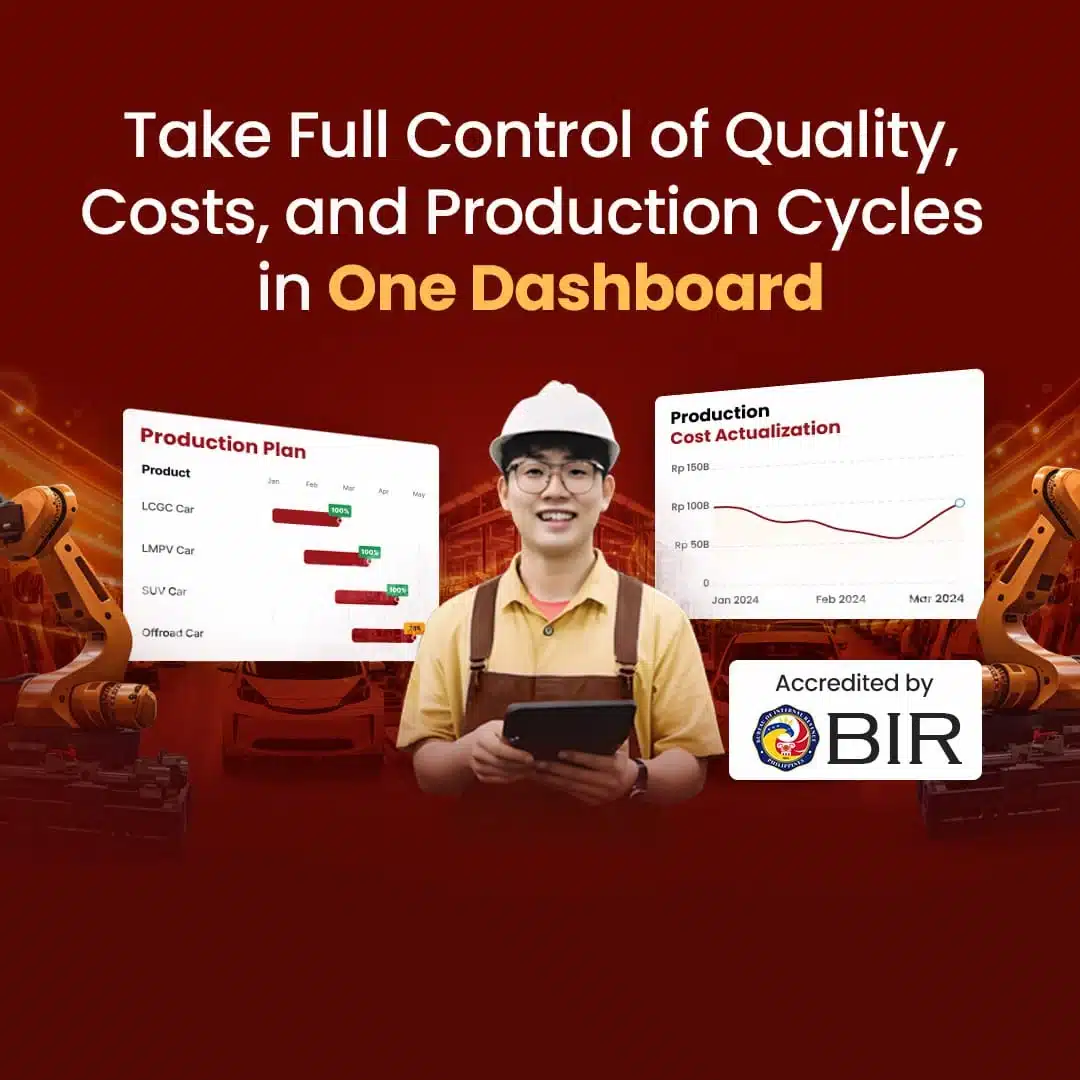Manufacturing facilities often struggle with overproduction, excess inventory, and disruptions in the supply chain, while urgent customer orders remain unfulfilled due to inefficient scheduling. Sound familiar? Unfortunately, this is an all too common scenario in today’s manufacturing landscape.
Without a robust system to streamline every step in the production process, businesses risk falling behind in an increasingly competitive market. This is where the production planning system comes into play.
According to the Deloitte survey, 48% of manufacturing companies adopted automation and smart factory initiatives as one of their top strategies in 2023. This shift highlights the growing reliance on advanced software and systems to streamline operations, enhance productivity, and reduce costs.
This article will help you understand how to implement effective production planning strategies and leverage the right software to transform your manufacturing operations.
Table of Contents

What is Production Planning?
Production planning is the process of organizing a company’s manufacturing activities to meet customer demand efficiently.
It predicts how much product customers will need, ensures the availability of the right resources such as materials and workers, and creates schedules for task completion.
The main goal is to make and deliver products on time while keeping costs low and using resources wisely. This is why effective product information management becomes crucial.
In production planning, companies first look at past data and market trends to guess future demand. Then, they assign resources to different production tasks and create detailed schedules to ensure everything runs smoothly by.
This includes managing inventory to avoid running out of materials or having too much stock. Effective PPIC helps companies operate smoothly, meet customer needs, and stay competitive.
On the other hand, an Enterprise Resource Planning (ERP) system extends beyond production planning to integrate various aspects of business operations into a unified platform.
While production planning is an essential component of ERP, the system also encompasses functions such as finance, human resources, supply chain management, customer relationship management, and more.
The Benefits of Production Planning System
Production planning serves as the foundation for efficient manufacturing operations. Production planning involves more than scheduling tasks and allocating resources; it essentially shapes a company’s ability to compete and thrive in the marketplace.
The following are the production planning system benefits to the manufacturing process:
1. Optimized cost management
Production planning is essential in cost control in manufacturing operations. By accurately forecasting demand and strategically allocating resources, companies can avoid the financial pitfalls associated with overproduction, such as excess inventory and storage costs.
On the contrary, it helps avoid production deficits, which can result in delayed shipments and missed sales opportunities. Effective production planning ensures resource efficiency, minimizes waste, and lowers overall production costs.
To achieve these benefits, manufacturers can rely on HashMicro’s advanced manufacturing software. HashMicro offers a comprehensive suite of tools designed to streamline production planning, enhance accuracy in demand forecasting, and optimize resource and inventory allocation.
By integrating HashMicro into your operations, you can significantly improve efficiency, reduce costs, and stay ahead of the competition. Try a free demo to see how HashMicro can help your production planning process by clicking this banner below.
2. Enhanced quality assurance:
A key aspect of production planning is ensuring high product quality. Through systematic organization of the production process, companies can ensure consistency at every step, following established standards.
This consistency facilitates early detection and resolution of potential quality issues, thereby reducing defects and rework. High-quality products mean fewer returns and complaints, thus improving the company’s reputation and customer confidence.
3. Strategic risk management
Production management system also plays an important role in risk management. By analyzing and anticipating potential production challenges, such as equipment failures, supply chain disruptions, or shifts in demand, companies can devise emergency plans to mitigate these risks.
This proactive approach ensures that manufacturing production schedule remain intact even in the face of unexpected obstacles, minimizing costly delays and maintaining stable operations.

4 Types of Production Planning
Production planning is crucial for ensuring that manufacturing processes run smoothly and efficiently. Different types of production planning cater to various manufacturing needs, each with its own set of strategies and goals. Here are the primary types of production planning:
Job production planning
Job production planning is used when manufacturing custom products or small batches tailored to specific customer requirements. Each job is unique and involves different materials, processes, and timelines.
This type of planning requires a detailed production scheduling system and coordination to ensure that resources are allocated effectively and that each job is completed to the customer’s specifications. It is commonly used in industries like custom furniture, specialized machinery, and bespoke clothing.
Batch production planning
Batch production planning involves producing goods in batches or groups, with each batch going through one stage of the production process before moving on to the next. This type is suitable for products that are identical or similar in design and require periodic manufacturing runs.
Batch production management system helps optimize resource use and reduce setup times between batches. It is widely used in industries such as food processing, pharmaceuticals, and consumer electronics.
Flow production planning
Flow production planning is designed for manufacturing processes where products are produced in a continuous, streamlined flow. This type of planning is ideal for high-volume, standardized products that require minimal variation.
The goal is to maintain a steady production rate with minimal interruptions, ensuring efficiency and consistency. Flow production planning is commonly found in industries like automotive manufacturing, chemical production, and steel manufacturing.
Mass production planning
Mass production planning focuses on producing large quantities of standardized products, often using assembly lines or automated processes. This type of planning aims to maximize production efficiency and minimize costs by taking advantage of economies of scale.
Mass production planning involves careful coordination of materials, labor, and machinery to maintain a high output rate. It is prevalent in industries such as consumer goods, electronics, and household appliances.
If you’re curious about how a production planning system can help you streamline your manufacturing business, you can find out how HashMicro meets your business needs through a free demo.
5 Steps to Make a Production Plan
Creating a production plan is essential for ensuring that manufacturing operations run smoothly and efficiently. By following a systematic approach, businesses can streamline their processes, optimize resource allocation, and meet customer demand effectively. Here are five key steps to make a production plan:
1. Demand forecasting
The first step in creating a production plan is to forecast demand for the products or services being manufactured. This involves analyzing historical sales data, market trends, and customer preferences to predict future demand accurately.
By understanding how much product customers are likely to need, businesses can plan their production schedules and resource allocation accordingly, avoiding the pitfalls of overproduction or underproduction.
2. Resource allocation
Once demand has been forecasted, the next step is to allocate the necessary resources to meet that demand. This includes determining the amount of raw materials, labor, and equipment needed for production.
Resource allocation involves balancing the availability of resources with production requirements, ensuring that there are no shortages or excesses that could disrupt operations.
Effective resource allocation maximizes efficiency and minimizes costs, helping businesses achieve their production goals within budget constraints.
3. Capacity planning
Capacity planning involves assessing the production capacity of the organization and ensuring that it aligns with projected demand. This includes evaluating the capacity of existing equipment, identifying any potential bottlenecks or constraints, and planning for future capacity expansions if needed.
By understanding the organization’s production capabilities, businesses can avoid overloading their resources and ensure that they can meet customer demand without compromising quality or efficiency.
4. Scheduling manufacturing production schedule
Once resources and capacity have been determined, the next step is to create a detailed manufacturing production schedule with advanced planning and scheduling. This involves organizing the sequence of production activities, determining when each task will be performed, and assigning resources to specific tasks.
The production schedule should take into account factors such as lead times, production constraints, and resource availability to ensure that production runs smoothly and efficiently.
5. Monitoring and adjusting
The final step in making a production plan is to continuously monitor production progress and make adjustments as needed.
This involves tracking key performance indicators, such as production output, inventory levels, and quality metrics, to ensure that operations are running as planned. If any deviations or issues arise, businesses should be prepared to adjust their production plan accordingly.
This may involve reallocating resources, rescheduling tasks, or revising production targets to address changing market conditions or unforeseen circumstances.
After knowing a few steps of product planning, it would be nice if you could consider the price calculation of HashMicro Manufacturing Software by clicking the image below. Immediately get success in your production operations with HashMicro.

3 Common Production Planning Mistakes
One of the best ways to avoid or mitigate problems once production has started is by being aware of the potential pitfalls ahead of time. The three most common production planning mistakes are:
- Not anticipating disruptions
In any complex production process, unexpected disruptions are likely to occur. It’s crucial that your production planning includes risk management strategies to anticipate and address potential issues.
This means having contingency plans in place for various scenarios, such as equipment failures, supply chain interruptions, or sudden changes in demand. Without these preparations, your production process can face significant setbacks.
- Neglecting on-site monitoring
While production management software provides real-time visibility into your production status, it’s essential to complement this with regular on-site visits.
These in-person observations allow you to gain valuable insights into the actual workings of your production line, which might not be fully captured by software alone.
- Lack of equipment maintenance
Regular maintenance of production equipment is essential to ensure smooth operations. Failure to maintain equipment can lead to unexpected breakdowns, causing delays and increasing repair costs.
It is crucial to have a preventive maintenance strategy in place, including a regular inspection schedule and a budget allocated for these activities.
By being aware of common mistakes in production planning such as anticipating disruptions, conducting on-site monitoring, and maintaining equipment, businesses can better prepare themselves for challenges that may occur, resulting in a smoother and more efficient production process.
Also read: Production Planning in ERP Finance Systems
How Can HashMicro Help You with Production Planning
Effective production planning is crucial for maintaining efficient manufacturing operations, reducing costs, and meeting customer demands. HashMicro’s manufacturing software offers a comprehensive solution for optimizing your production planning process.
With its robust features and user-friendly interface, HashMicro can significantly enhance your manufacturing efficiency.
Key Features of HashMicro’s Manufacturing Software:
- Advanced scheduling: Automatically generate and manage production schedules, ensuring optimal resource allocation and minimizing downtime.
- Real-time monitoring: Keep track of production activities in real-time, enabling quick identification and resolution of issues to maintain smooth operations.
- Material requirements planning (MRP): Accurately forecast and manage material requirements to avoid shortages and excess inventory, ensuring a balanced supply chain.
- Inventory management: Efficiently track and control inventory levels, reducing storage costs and preventing overproduction or underproduction.
- Demand forecasting: Utilize historical data and market trends to predict future demand, aligning production schedules with customer needs and reducing the risk of stockouts or excess stock.
- Quality control: Integrate quality checks at every stage of production to ensure consistent product quality, reducing defects and enhancing customer satisfaction.
- Capacity planning: Analyze production capacity and plan workloads accordingly to prevent resource overburdening and ensure timely product delivery.
- Integration capabilities: Seamlessly integrate with other business systems such as ERP, CRM, and SCM for comprehensive management and coordination across departments.
- Customizable dashboards: Tailor the software interface to your specific needs, providing easy access to key performance indicators and critical data for informed decision-making.
HashMicro production planning software is designed to streamline production planning and control. It provides an all-in-one platform that integrates various aspects of the manufacturing process, ensuring seamless coordination and execution.
By leveraging this powerful software, manufacturers can achieve greater efficiency, accuracy, and flexibility in their operations.
HashMicro offers a robust and flexible solution for production planning in the manufacturing industry. Its advanced features and seamless integration capabilities make it an invaluable tool for optimizing manufacturing operations.
By choosing HashMicro, manufacturers can achieve greater efficiency, accuracy, and overall performance in their production processes.
Conclusions
In the competitive world of manufacturing, effective production planning is vital for success. It ensures that resources are used efficiently, production schedules are met, and customer demands are satisfied.
In addition, effective production planning enables businesses to respond quickly to changing market dynamics and customer preferences, remaining agile and adaptable in the middle of evolving industry trends.
To optimize production planning, leveraging advanced software solutions like HashMicro’s manufacturing software is essential. HashMicro provides a comprehensive platform that integrates scheduling, real-time monitoring, material requirements planning, inventory management, demand forecasting, quality control using manufacture execution system, capacity planning, and more.
Discover how HashMicro’s manufacturing software can transform your manufacturing operations. Try our free demo and experience the benefits of robust and efficient production planning software.




































